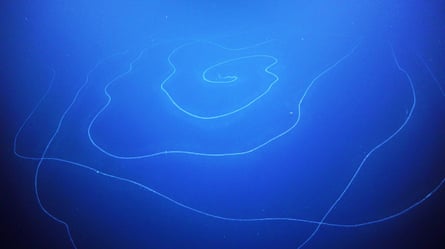In 2020, about 600 metres (2,000ft) down in an underwater canyon off the coast of Western Australia, scientists encountered a long gelatinous creature suspended in a giant spiral. “It was like a rope on the horizon. You couldn’t miss it,” says Nerida Wilson from the Western Australian Museum. “It was so huge.”
It was a deep-sea siphonophore, a relative of the portuguese man o’ war, or blue bottles, that bob like party balloons on the sea surface, trailing deadly tentacles through the water. This one was probably a new species from the genus Apolemia, a group that generally look like tangled feather boas.
Q&AWhat is the Discovered in the deep series?
Show
The ocean is one of the world’s last truly wild spaces. It teems with fascinating species that sometimes seems to border on the absurd, from fish that look up through transparent heads to golden snails with iron armour. We know more about deep space than deep oceans, and science is only beginning to scratch the surface of the rich variety of life in the depths.
As mining companies push to industrialise the sea floor and global leaders continue to squabble over how to protect the high seas, the Guardian's Seascape series, Discovered in the deep, will profile some of the most recently discovered weird, wonderful, majestic, ridiculous, hardcore and mind-blowing creatures. They reveal how much there is still to learn about the least known environment on Earth – and how much there is to protect.
The spiral arrangement is known to be a feeding posture in these types of siphonophores. Numerous stinging tentacles create a wall of death in the water, trapping small prey, including crustaceans and fish.
Finding it was one of the chance encounters that are common in deep-sea research. The scientists’ aim was to study life on the deep seabed, and they just happened to come across this floating jelly while their submersible was on its two-hour transit back to the ship, the research vessel Falkor, then run by the Schmidt Ocean Institute.
Screens in different parts of the Falkor were transmitting live footage from the submersible. Wilson describes how everyone onboard was simultaneously mesmerised and puzzled when the enormous spiral came into view. They all swarmed into the control room to get a better look. “It was such a beautiful energy,” says Wilson. “Everyone was like, ‘What is this?’”

Time was already short because the dive had run over schedule, and so the submersible pilot, controlling it from the surface, could only spend a few moments with the animal. “We circled around, took some footage and a little sample of tissue,” Wilson says. “Then we just had to go on our merry way.”
Siphonophores look like jellyfish, and they do belong to the same group of animals, but they build their bodies in a unique way – more like hundreds of tiny jellyfish stuck together. Yet, a siphonophore is a single organism. “It did have two parents,” says Wilson. “It was a product of sex.”
Rather than growing in a more conventional way into a body with organs that carry out different functions, siphonophores consist of individual parts called zooids. Some zooids are responsible for feeding, some for reproduction, and others move and steer the animal through the water. “They’re just an example of doing things a bit differently,” says Wilson. “They’re one and they’re many.”
Based on a rough calculation from the submersible’s track, the spiral-shaped siphonophore is a candidate for the longest specimen ever encountered. At about 45 metres (150ft), it could even be the longest animal ever to be measured, much longer than a blue whale.
Reluctant to claim any world records just yet, Wilson is working with a specialist in photogrammetry to get a more accurate estimate of the siphonophore’s size. It is not an easy task to extract three-dimensional information from the video, because the siphonophore moved about in the wake of the submersible’s thrusters. “Normally with photogrammetry, you’re going back and forth over a fixed object,” Wilson says. “This is technically a bit more challenging.”